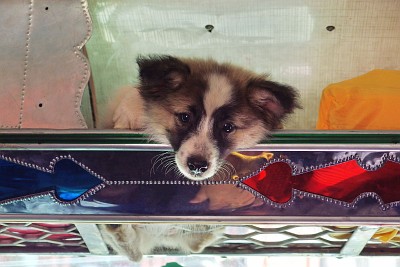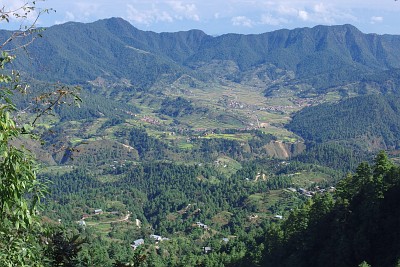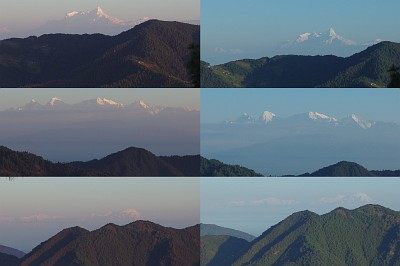Daman Detour
(vero;2017-May-01)
We also have a photo gallery dedicated to this trip.
After our Manaslu and Annapurna trek and a few days rest in Pokhara, we decide to embark on a small road trip to Daman, stopping en route in Tansen and Hetauda. Daman, about 75 km southwest of the capital, is famous for its great views of the Himalayas and it is about time that we go and have a look.
 We leave Pokhara on October 15th, the last day of the Dashain festival and our bus is already full when we leave the city. The first third of the journey is actually quite pleasant but we pick more and more people as we make progress, there are many families waiting on the road side for a ride back home and it does not take long before the bus is filled to the brim. And when we say this, we mean it: people are pushed, compressed and squeezed inside in such an extent that we start to wonder whether there is a hole at the back where they all disappear to make space for the new arrivals. But we know that there is no such thing as a full bus in Nepal, not mentioning the masses perched on the roof or hanging on the outside. The situation is quite dramatic and each stop increases the tension although people remain good natured: main thing is to get a ride and we are all in this together. A family proves particularly clever as they send a man up the road to catch our bus and bribe the conductor with the effect that we do not pick up passengers for a while until we arrive in a certain village where the rest of the numerous family is waiting. Imagine the chaos as other people also waiting and desperate for a ride understand what is going on: it ensues a heated discussion as travellers are outraged and try to stop the family to board before them. What a spectacle! But in the end, as so often, money rules the world and the family eventually embarks safely, plus a few more of course …
We leave Pokhara on October 15th, the last day of the Dashain festival and our bus is already full when we leave the city. The first third of the journey is actually quite pleasant but we pick more and more people as we make progress, there are many families waiting on the road side for a ride back home and it does not take long before the bus is filled to the brim. And when we say this, we mean it: people are pushed, compressed and squeezed inside in such an extent that we start to wonder whether there is a hole at the back where they all disappear to make space for the new arrivals. But we know that there is no such thing as a full bus in Nepal, not mentioning the masses perched on the roof or hanging on the outside. The situation is quite dramatic and each stop increases the tension although people remain good natured: main thing is to get a ride and we are all in this together. A family proves particularly clever as they send a man up the road to catch our bus and bribe the conductor with the effect that we do not pick up passengers for a while until we arrive in a certain village where the rest of the numerous family is waiting. Imagine the chaos as other people also waiting and desperate for a ride understand what is going on: it ensues a heated discussion as travellers are outraged and try to stop the family to board before them. What a spectacle! But in the end, as so often, money rules the world and the family eventually embarks safely, plus a few more of course …
Click on the arrow to get a taste of Nepalese travel in a local bus: 
No need to say that we are glad to reach Tansen after 6 hours drive (for 126 km). Tansen, also called Palpa, is a quintessential Nepali town sitting on a ridge high above the Kali Gandaki river which comes down from Tibet and along which we trekked from Kagbeni to Chitre. It was the last kingdom to be incorporated into Nepal (independent till 1806) and there is still some of this independence in the air. There are not many famous sights, just a few nice temples but simply strolling through the town is pleasant enough and there are nice views of the Himalayas to be had too. Furthermore, Tansen (1350m high) sits like a spider in a complex web of ridges and walking possibilities abound. This is our third visit and here again, we realise that things are changing fast in Nepal. Most dirt roads around town are now paved, old trails are widened and changed into dirt roads and Tansen is developing into an important traffic hub for the outlying villages. Some of the walks we used to enjoy are now plagued by traffic and one has to escape further away to enjoy the peaceful countryside but the town is still very enjoyable and it is a good idea to stop here and visit.
From Tansen we head first to the town of Butwal, our gateway into the Terai plain where we have to change bus to continue to Hetauda. Roads in the Terai are relatively good and we arrive early in the afternoon which gives us enough time to explore the town. There is nothing special to see in Hetauda but we enjoy its friendly and colourful atmosphere which reminds us of India: many people going about their business and plenty of good eating joints around.
We catch the first bus to Daman the next morning. The drive is very scenic and we are lucky to have a seat just behind the driver so that we can enjoy the mountainous landscape and follow the road as it winds up and down the hills. This road is not any road: it is the so-called Tribhuvan Highway, the first road ever built in Nepal, linking Naubise, 25 km west of Kathmandu with the Indian border town of Raxaul in the Terai. It was constructed with Indian aid in 1956 and has long been the only road connecting the Nepalese kingdom with the rest of the world.
 It is only 32 km from Hetauda to Naubise as the crow flies, but it takes the road 107 km to overcome the mountain range lying between both towns. The highway is not busy anymore as new roads have been built which provide quicker access to the Terai but we are nevertheless surprised that quite a few lorries use it in spite of its narrow width and many curves. More striking is the regular traffic of brand new vehicles: this road is obviously the itinerary of choice to bring cars manufactured in India from the border to their Nepalese buyers. Hyundai and Skoda seem to be in high demand as well as small pick-ups from Mahindra, all driven with a temporary number plate, factory stickers on the outside and plastic covers to protect seats and floor on the inside. As for new lorries, they are driven in their barest form with only a driver cabin and the trailer chassis, the body being designed and built to customers' needs in the numerous workshops of Kathmandu Valley.
It is only 32 km from Hetauda to Naubise as the crow flies, but it takes the road 107 km to overcome the mountain range lying between both towns. The highway is not busy anymore as new roads have been built which provide quicker access to the Terai but we are nevertheless surprised that quite a few lorries use it in spite of its narrow width and many curves. More striking is the regular traffic of brand new vehicles: this road is obviously the itinerary of choice to bring cars manufactured in India from the border to their Nepalese buyers. Hyundai and Skoda seem to be in high demand as well as small pick-ups from Mahindra, all driven with a temporary number plate, factory stickers on the outside and plastic covers to protect seats and floor on the inside. As for new lorries, they are driven in their barest form with only a driver cabin and the trailer chassis, the body being designed and built to customers' needs in the numerous workshops of Kathmandu Valley.
 Of course, we stop in Daman for the night. This is a small resort high on a ridge commanding a wide view of the Himalayas from Everest in the east to Kanchenjunga, Lhotse, Makalu, Cho Oyu, Manaslu, Annapurna and Dhaulagiri to the west. Alas, clouds are blocking the view the next morning and we just catch a blurred glimpse of the Langtang range to the east and a snowy triangle to the west. But we don't give up: we decide to stay an other night and spend the day walking along the road to the next village of Palung, 9 km further down. This is actually a very nice walk, traffic is light enough not to disturb us, the views down valley are nice, fields of marigolds brighten the scenery and the slope gradient is so low that it is not strenuous to walk back to Daman in the afternoon. People are busy in the fields, harvesting cabbage and white radish (called “mula” in Nepalese as we learn): the vegetables are brought to the road where they are packed in 30 kilo bags which are then collected by lorries and brought down to the Kathmandu Valley. We meet women on the road, laden with leaves which they collect in the woods and bring back to fertilise their fields.
Of course, we stop in Daman for the night. This is a small resort high on a ridge commanding a wide view of the Himalayas from Everest in the east to Kanchenjunga, Lhotse, Makalu, Cho Oyu, Manaslu, Annapurna and Dhaulagiri to the west. Alas, clouds are blocking the view the next morning and we just catch a blurred glimpse of the Langtang range to the east and a snowy triangle to the west. But we don't give up: we decide to stay an other night and spend the day walking along the road to the next village of Palung, 9 km further down. This is actually a very nice walk, traffic is light enough not to disturb us, the views down valley are nice, fields of marigolds brighten the scenery and the slope gradient is so low that it is not strenuous to walk back to Daman in the afternoon. People are busy in the fields, harvesting cabbage and white radish (called “mula” in Nepalese as we learn): the vegetables are brought to the road where they are packed in 30 kilo bags which are then collected by lorries and brought down to the Kathmandu Valley. We meet women on the road, laden with leaves which they collect in the woods and bring back to fertilise their fields.
The next morning brings a nice surprise: the horizon is clear and we rush to the ridge where we admire the view from Dhaulagiri to Langtang Himal and clearly identify Dhaulagiri, Annapurna, Manaslu and Ganesh Himal.
The first bus to Kathmandu is not due before 11 am and as it comes from Hetauda it will be probably packed. We are not so keen on a repeat of the Tansen experience, so we decide to walk down to Palung again and catch a bus starting from there. This is a very good idea: we hitchhike as we walk and a lorry driver stops about midway and brings us to Palung just in time for the 9 am bus. We are lucky and get front seats again, which means that we can enjoy the scenery and have perfect views of the Annapurnas and Manaslu as the road winds down: a great drive, one of the best in Nepal and one of the highlights of our Nepal 2016 journey.
You might now want to check our photo gallery dedicated to this trip.
Want to read more? Go back to From Kagbeni to Pokhara or go on to Solukhumbu Foothills or go up to Blog
$updated from: Blog.htxt Mon 04 Mar 2024 16:04:40 trvl2 (By Vero and Thomas Lauer)$



